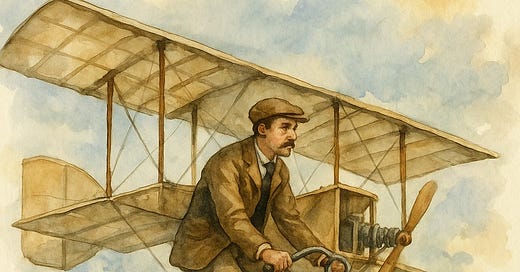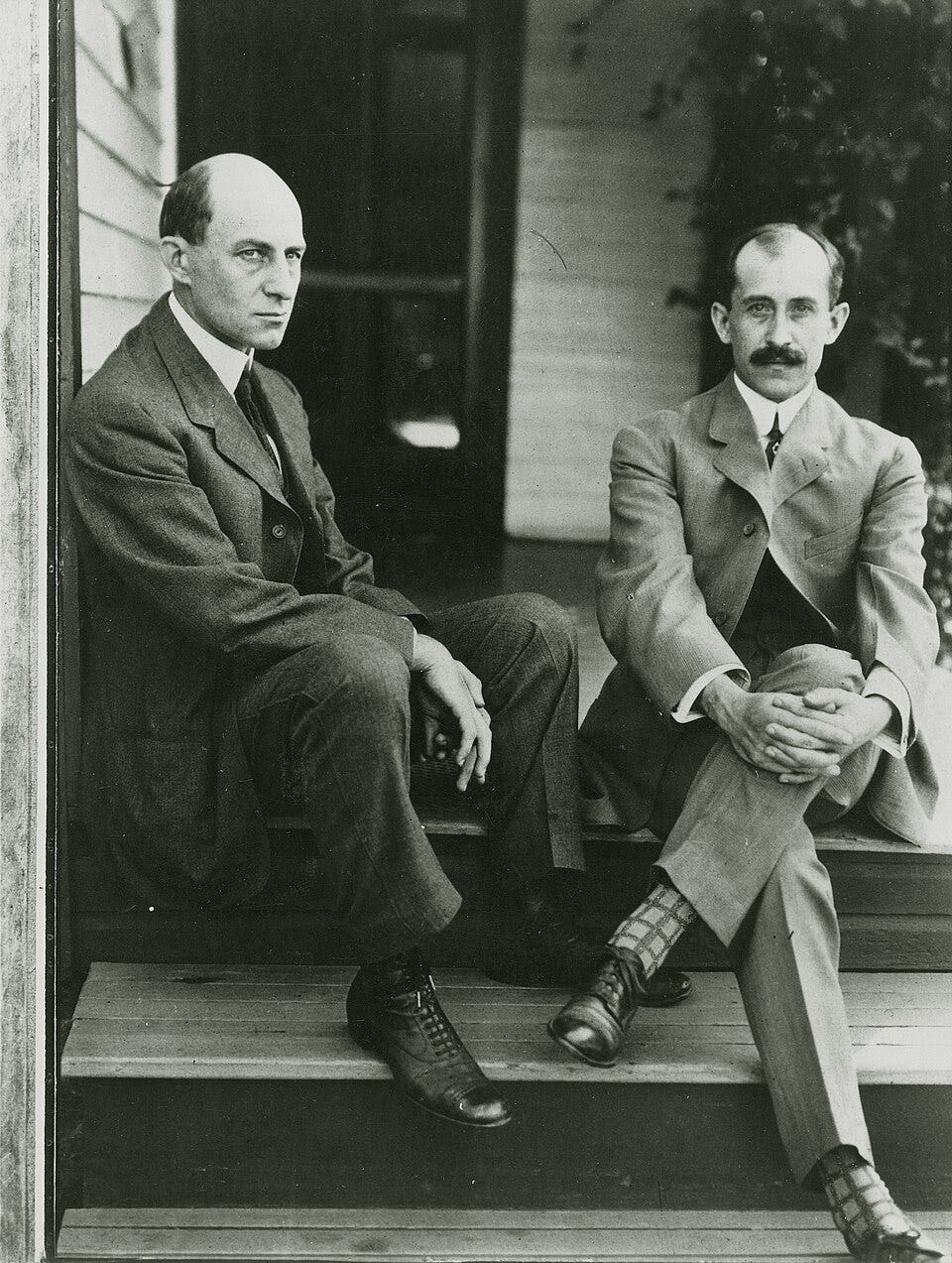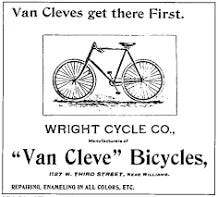OTHER LIVES
Lily Tomlin used to do a funny routine about a woman who badly wanted to be a Howard Johnson's head waitress, but all she could get were acting jobs.
Tomlin had in fact been a waitress at the Howard Johnson's on Broadway in New York, and told columnist Earl Wilson in 1968, "I would get at the mike and say, 'Attention diners! Your waitress of the week, Lily Tomlin, is about to make an appearance on the floor. Let's give her a hand!' Then I’d walk out and nod and take a lot of bows."
Presumably, Tomlin wouldn't actually exchange the life she has had with the head waitress she might have been. And yet — this is pure supposition — I imagine she would look back on those times as great, uncomplicated fun. Perhaps it was this way for the Wrights: pioneers of aviation for history, but bikers any day of the week.
THE ROVER LANDS
Wilbur Wright was born in 1867, Orville in 1871, at the time penny-farthing bikes, with their jumbo front wheel, teeny-tiny back wheel, and elevated seat, were becoming popular. The problem was that the design of the bikes made them dangerous to ride. If the riders, almost exclusively men, tried anything but the gentlest of turns or braking, they were rewarded with a head-first ejection, game over.
The game-changer came in 1885 when John Kemp Starley introduced the Rover Safety Bicycle similar to the ones we still ride today, with two equal-sized wheels and pneumatic tires. As a result, the 1890s saw a bike boom in the U.S. and Europe, one in which women participated equally with men.
Susan B. Anthony said in 1896, "Let me tell you what I think of bicycling. I think it has done more to emancipate women than anything else in the world. It gives women a feeling of freedom and self-reliance. I stand and rejoice every time I see a woman ride by on a wheel...the picture of free, untrammeled womanhood." In fact, men, women, and children all quickly became biking disciples for the same reasons.
In 1892, as the bike boom got into gear, the brothers were running a print shop in Dayton, Ohio, though neither of them finding it fulfilling. That spring, Orville bought one of the new-style bikes and Wilbur bought his a few months later.
In short order, they became as enamored of biking as the rest of the country and, within months, they decided to start a bike repair business. It wasn't long before the Wright Cycle Company expanded beyond repairs, producing their own bikes, made by hand and to order.
DEFYING GRAVITY
Many bike enthusiasts at the time described the sensation of biking as akin to flying, connecting the sensations of a swift ride with the raging debate of the era: could man actually, ever fly? Wilbur and Orville became increasingly captivated by the idea, and convinced that some measure of manned flight was possible.
Ultimately, Wilbur had his great insight into flying, in part from his work with bicycles, in part from the brothers' observations of birds and how they used their wingtips.
Prevailing wisdom had been that stability of the craft was the most important factor. To put it simply, Wilbur concluded that in order to fly, less stability was acceptable, but more maneuverability was essential, similar to the kind of dynamic balance needed for biking.
The experiments at Kitty Hawk, as well as the larger story of the brothers' lives, is documented in Tom Crouch's excellent book The Bishop's Boys: A Life of Wilbur and Orville Wright.
ON TOP OF THE WORLD
It wasn't until I came across a letter that Wilbur had written to his younger sister, Katharine, and niece, Helen, on September 18, 1892, that it became evident to me that some of the brothers' greatest joys were out on the road, biking together, lost in the simple pleasures of a ride. The events described may not count as high drama, but the exhilaration that Wilbur feels is palpable even from this distance.
We had a good rain Tuesday and the roads have been good for bicycling since. Thursday afternoon we put on our suits (we are rigged up since you left) and left home at 4:15 o'clock for a run to Miamisburg. We decided to go down via the Cincinnati pike. We stopped at the Fair grounds and ran around the track a couple times, then started South and began to climb...we climbed and the we "clumb" and then climbed again...[It] looked a good deal like this only I had to foreshorten the top of the hill when I came to the writing instead of continuing it up about four feet just past the north east corner of the paper.
Finally we got to the top and thought that our troubles were over but they were only begun for after riding about half a mile the road began to "wobble" up and down something after the following fashion.
At last we got to the top of the hill marked "A" and met a man mowing hay by the road side. I said "We must be getting nearly to the top of the world aren't we?" He pointed to a mountain about three fourths of a mile away and said "Centerville is the highest point in the county." Oh yes, we were going to Miamisburg in great shape!
Following their visit, the brothers set off home.
It was just twenty three minutes till seven as we pulled out of the "Burg" and so dark that we could hardly see the road...We kept in the track more by feeling than seeing.
In one place we came near running over a wagon loaded with empty boxes. The boxes were piled up eight or ten feet but we did not see them till we were almost upon them. If we had run over them it would have been a feat of hill climbing sure enough.
This experience set Orville's imagination (always active you know) to work and pretty soon he clapped on breaks and nearly threw himself from his 'bike' to keep himself from running down a hill into a wagon just crossing a little bridge. When he came to the place he found no hill, no bridge, and no wagon, only a little damp place in the road which showed up black in the night.
We reached home at 7:35, three hours and twenty minutes from the time we started and fifty eight minutes from Miamisburg. The total distance we made was between thirty and thirty one miles. The roads were fine shape, hard and smooth, and the air was just cool enough to be nice. We felt fresher and less tired when we got home than we did after climbing the "classic height and etc."
Now, compare that letter with the September 29, 1909 report from the New York Times on Wilbur's flight around the Statue of Liberty. The Times reported that the crowd, estimated at one million spectators, responded with "exultant excitement." And yet, Wright's enthusiasm was contained. The Times wrote, "After it was all over he had, as usual, little to say. 'The flights,' said Mr. Wright, 'spoke for themselves.'"
ALL OF THE ABOVE
Sometimes a hobby is a pastime, sometimes it becomes a business, one in a million times it's a leap into history. For the Wright Brothers, it was all three. Still, Wilbur's letter is an ode to the bike. His enthusiasm is unmistakable, you can hear Wilbur's humor, his amusement at Orville's imagination, feel the joy in the doodles.
Whether you set your sights on being the head waitress at Howard Johnson's or working in show business, whether you want to cycle or fly, the grass is always greener, the sky is always bluer on the other side. But sometimes, you get to choose all of the above.
FURTHER READING
The Mechanical Horse: How the Bicycle Reshaped American Life
The Untold Story Of How Bicycle Design Led To The Invention Of The Airplane









Thought provoking: a bike as a means to women's liberation. Never thought of that, but of course!